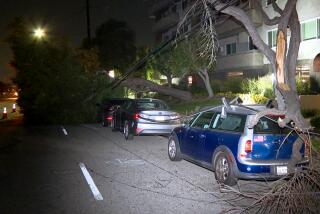Snowflakes Dot Foothills, Desert in Southland Chill
- Share via
Snow sprinkled the foothills around the Los Angeles Basin and dusted desert communities from Palm Springs to Needles early Saturday as a fast-moving cold front swept through Southern California, dropping temperatures into the 30s and 40s.
The Los Angeles Civic Center recorded an overnight low of 43 degrees and a rainfall of .28 of an inch. Similar amounts of precipitation fell in other areas, turning to snow at higher elevations in the San Gabriel and San Bernardino mountains and foothills.
Chains were required for motorists traveling Interstate 15 over the Cajon Pass as snow fell in Victorville and other high-desert communities. Farther north, southbound lanes of Interstate 15 were closed for three hours Saturday morning in the Tejon Pass area after a truck jackknifed on the snow-covered highway.
Southern Californians shivered as morning temperatures dropped into the 30s in some areas. And, in Palm Springs, where snow accumulated on rooftops for a time, the thermometer stood at 38 degrees at 1 p.m.
The National Weather Service blamed a front moving southeast out of the Gulf of Alaska for Saturday’s snow and low temperatures. By late afternoon, the system had moved into the desert on its way out of the area.
But the weather service said that the air over Southern California still will be moist and unstable enough to produce variable cloudiness today and continued cool temperatures. It is expected to warm up by Monday or Tuesday.
The high at the Civic Center was 59 degrees on Saturday under partly cloudy skies. No new records were established.
Besides the cold, Saturday also saw unusually low tides.
At the Bolsa Chica Ecological Reserve near Huntington Beach, a larger than usual area of mud flats was exposed in the outer bay, attracting marine birds and bird-watchers to the 557-acre coastal reserve. The tides are expected to be even lower today.
Meanwhile the good news from the Santa Ana Zoo was that B. J., the only groundhog in a Southern California zoo, did not see his shadow when he emerged from his burrow under cloudy skies after a rainstorm Saturday morning, zoo officials said.
“He poked his nose around for a while and stayed out about a half hour,” said associate curator Warnie McIlwaine.
Tradition holds that if a groundhog sees its shadow when it comes out of winter hibernation on Feb. 2, Groundhog Day, it will return to its hole and winter will continue for another six weeks. But B. J. has adjusted his winter sleeping pattern to California weather by ending his hibernation in late January, McIlwaine said.
On whether B. J. saw his shadow or not, McIlwaine said: “It was cloudy, so I doubt it.”
More to Read
Sign up for Essential California
The most important California stories and recommendations in your inbox every morning.
You may occasionally receive promotional content from the Los Angeles Times.













